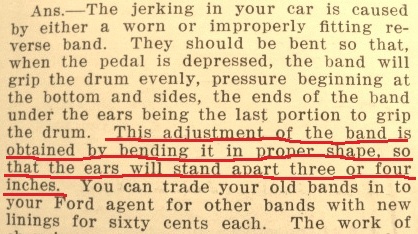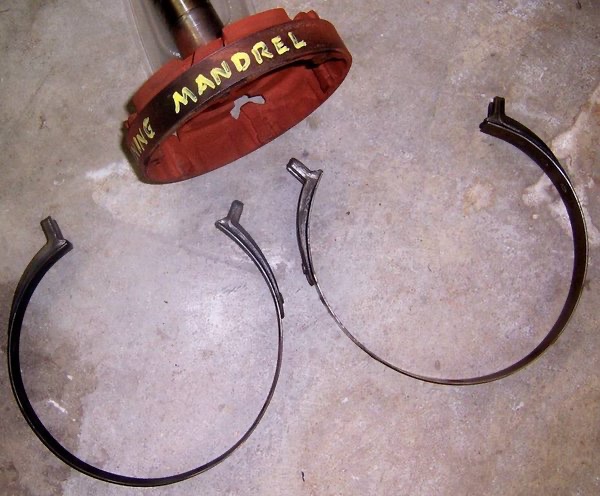Page 1 of 1
Drum Dia
Posted: Tue Feb 08, 2022 10:16 am
by dunoon
Does anyone know the dia of transmission drums for a 26. I'm thinking for using a local machine shop to turn a small piece of pipe to make a gage to shape my bands. Thanks
Re: Drum Dia
Posted: Tue Feb 08, 2022 10:35 am
by speedytinc
7.500"
Re: Drum Dia
Posted: Tue Feb 08, 2022 11:22 am
by Art M
I would be a whole lot more affordable to use a junk drum. There are plenty of them out there. I only have one for the same purpose. There must be someone on the forum with an extra scrap drum.
Art Mirtes
Re: Drum Dia
Posted: Tue Feb 08, 2022 11:30 am
by speedytinc
Even cracked drums. But shipping costs make a "free" drum too expensive. A fellow, local club member's junk or a swap meet find.
Re: Drum Dia
Posted: Tue Feb 08, 2022 12:19 pm
by Bryant
On the model t tips video the guy uses a emergency brake drum to check for roundness. I measured my 26 trans drum and it is 7.5” I am assuming it’s a small drum axle. I was looking last night but all I could find was the small drum diameter is just under 8”. Maybe someone here knows?
Re: Drum Dia
Posted: Tue Feb 08, 2022 12:28 pm
by Jerry VanOoteghem
Bryant wrote: ↑Tue Feb 08, 2022 12:19 pm
On the model t tips video the guy uses a emergency brake drum to check for roundness. I measured my 26 trans drum and it is 7.5” I am assuming it’s a small drum axle. I was looking last night but all I could find was the small drum diameter is just under 8”. Maybe someone here knows?
Yup, that's what I do. Works perfectly, even if the diameters are a tad off.
Re: Drum Dia
Posted: Tue Feb 08, 2022 1:19 pm
by Bryant
thanks that's good to know. lots of options to choose from. I am a big fan if recycling to.
Re: Drum Dia
Posted: Tue Feb 08, 2022 4:25 pm
by Jerry VanOoteghem
Jerry VanOoteghem wrote: ↑Tue Feb 08, 2022 12:28 pm
Bryant wrote: ↑Tue Feb 08, 2022 12:19 pm
On the model t tips video the guy uses a emergency brake drum to check for roundness. I measured my 26 trans drum and it is 7.5” I am assuming it’s a small drum axle. I was looking last night but all I could find was the small drum diameter is just under 8”. Maybe someone here knows?
Yup, that's what I do. Works perfectly, even if the diameters are a tad off.
Still, it shouldn't soooo hard to find a cracked reverse drum to use...
Re: Drum Dia
Posted: Tue Feb 08, 2022 5:07 pm
by Wayne Sheldon
Lots of opinions out there. Here is another one.
The natural at rest shape of the band is supposed to be larger than the drum it clamps onto under pressure! Therefore, your "drum anvil" should be larger than the transmission drum by over a half inch.
Whatever you use for an anvil? The band should be tightened onto the anvil using a common bolt and nut. Do not over-tighten! But a snug pull around your anvil followed by light hammer taps (I often use a lightweight body hammer) will give better results.
Sometimes a slightly smaller anvil should be used. Especially if the band has a significantly straightened area that needs to be brought back into round. I straightened one badly twisted band by rounding it first to too small, then re-rounding it again to the proper larger size. It came out just fine and gave good service for several years before I sold the car.
I met a fellow once that had larger acetylene tanks than I use. They were a good inch larger diameter than the transmission drums. He liked that size for straightening the bands. I thought they were a bit too large?
Sometimes I use the rear wheel small brake drums. That size seems to work fine. I also have a really rusty and frozen together model T transmission sitting outside my shop that I have been putting oil onto and into for ten years now trying to get it apart (really stubborn! Both the transmission and me?). I sometimes use it as my band anvil since it is handy. Although the anvil should be slightly larger than the drums? Anything from drum size to an inch larger should work fine.
Re: Drum Dia
Posted: Tue Feb 08, 2022 7:15 pm
by Art M
An acetylene tank should never be used for an anvil. These tanks are too dangerous to be pounding on. There is a reason that these tanks are supposed to be chained when in storage.
Art Mirtes
Re: Drum Dia
Posted: Tue Feb 08, 2022 9:14 pm
by Mark Gregush
The reason the tanks are chained, is because if they fall over and the valve gets broke off or damaged, they can take off like a missile. Still, I would find something else to use as an anvil before I would even entertain the thought of using one for that.
Re: Drum Dia
Posted: Tue Feb 08, 2022 11:05 pm
by Charlie_26_TT_Ccab
Acetylene tanks should not be stored, transported
Or layed on their sides as it can cause the acetone to
become unstable and cause the acetone liquid to back up into the valves and gauges. If tanks are layed on their sides they should be stored upright to settle before being used again. Laying tanks on their sides or standing while using as an anvil is probably not a good idea. Just saying!
Re: Drum Dia
Posted: Wed Feb 09, 2022 4:49 am
by Wayne Sheldon
I wasn't saying I liked the idea of using the acetylene tank as an anvil, just that someone else liked the size he had for that purpose. If you are striking your bands hard enough to damage an acetylene tank? You most likely have damaged the hardened steel in the band enough that it is no longer good to to be used in a transmission. As I mentioned earlier, " followed by light hammer taps (I often use a lightweight body hammer) will give better results."
Appropriately light hammer taps will not damage an acetylene tank (as long as they are at least a foot away from the neck!). But I still generally don't do that.
The cleaver way the acetylene is suspended in acetone allows the tank pressure of the acetylene to be low enough that there is not a significant explosive risk with the acetylene tanks. Certainly fire and potential explosive risks after a tank is ruptured or allowed to leak the potentially explosive fuel in an enclosed space. But the acetylene tanks themselves do not pose a significant explosion risk.
The oxygen tanks on the other hand, when full, are pressurized to about 2200 psi, times about a thousand square inches of steel tank (if my quick in head estimate isn't off too far?) equals a VERY significant explosion risk!!! Full oxygen tanks have been known to take off like rockets and go THROUGH foot thick concrete walls! Even a nearly empty oxygen tank (down in the low hundreds psi) can cause serious injury or death if the neck is suddenly broken. Even if the nearly empty tank is chained down, the sudden burst of nearly pure oxygen can cause mildly flammable materials to burst into flames! Some materials when exposed to nearly pure oxygen can burst into flames even without any outside heat or spark to ignite them.
So both oxygen and acetylene tanks do pose risks! Risks that should be understood and appropriate precautions taken (ALWAYS!). However, fearing the wrong risks for the tanks at hand doesn't help. Although "better safe than sorry" sometimes does help.
Re: Drum Dia
Posted: Wed Feb 09, 2022 8:30 am
by DanTreace
Good plan to make or use a mandrel to shape those bands. Many times they can be twisted out of shape and most times the ears are too far apart from over-bending to get into or out through inspection cover opening .
When you get final straightness, then check to be sure the band ears are approx. 4" apart.

- IMG_9798 (2).jpg (92.27 KiB) Viewed 3181 times
Typical stretched apart bands.

- drum mandrel for bands.jpg (109.36 KiB) Viewed 3181 times
Mandrel fitted band, shaped carefully with small mallet blows to get round shape, pulling ears tightly around the drum and tapping to get lug ears spacing correct.
Re: Drum Dia
Posted: Wed Feb 09, 2022 8:32 am
by speedytinc
Anvil? Why are we beating on the band. Never had to, myself, just hand bend. Sometimes put the ends in a vise to bend for the proper ear "snap in" after the band is re-shaped.
The round gauge is for testing fit when closed, not beating against.
Small drum brake is 8.25" dia. Inside iron shoe is 7 & 15/16", closer. Other than an old transmission drum, I like the idea of a thick plywood disk.
Re: Drum Dia
Posted: Wed Feb 09, 2022 12:43 pm
by Harry Lillo
I appreciate the effort that goes into reshaping the bands and aligning the ears before installation.
In my view this works well for an engine and transmission that is out of the car and the bands can be
installed from the back of the transmission without distortion.
What about the case where you are installing bands with demountable ears through the inspection cover?
Do you lose your perfect shape? I find the band straightens out considerabley as it enters the transmission.
Harry Lillo
Re: Drum Dia
Posted: Wed Feb 09, 2022 1:43 pm
by speedytinc
Harry Lillo wrote: ↑Wed Feb 09, 2022 12:43 pm
I appreciate the effort that goes into reshaping the bands and aligning the ears before installation.
In my view this works well for an engine and transmission that is out of the car and the bands can be
installed from the back of the transmission without distortion.
What about the case where you are installing bands with demountable ears through the inspection cover?
Do you lose your perfect shape? I find the band straightens out considerabley as it enters the transmission.
Harry Lillo
Yes, it looses its shape & why it's VERY inadvisable to install kevlar thru the the inspection cover.
The effort is not necessarily completely wasted starting with a correctly formed band & handling/installing as gently as possible.
Re: Drum Dia
Posted: Wed Feb 09, 2022 6:14 pm
by tman1913
This is how I repair the steel transmission drum bands
All that’s needed is rear brake drum. Two can be used, stacked on top of each other, when working on the wide brake drum but I don’t find the need often.
C clamp locking type vise grip and some heat. Place the band around the brake drum and use the vise grip to pull the band tight. Not a lot of pressure is required. Starting at one of the ears heat the band to a dull red with a torch and work to the other ear.
Easy to do. Try it you may like it.